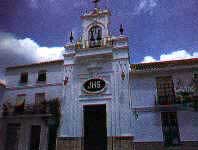 Alhaurín el Grande, a charming town nestled at the foot of the north face of the Sierra de Mijas, is a sight to behold. Overlooking the stunning Guadalhorce valley, its territory is dotted with citrus orchards and other fruit trees, creating a dreamlike landscape. This place has witnessed history, with Neolithic settlers, Phoenicians, Greeks, Romans, and Arabs leaving their mark on the land.
Alhaurín el Grande, a charming town nestled at the foot of the north face of the Sierra de Mijas, is a sight to behold. Overlooking the stunning Guadalhorce valley, its territory is dotted with citrus orchards and other fruit trees, creating a dreamlike landscape. This place has witnessed history, with Neolithic settlers, Phoenicians, Greeks, Romans, and Arabs leaving their mark on the land.
Today, Alhaurín el Grande is a thriving town with interesting monuments such as the Church, the Town Hall, and the Montellano Palace. A particular point of interest is the Los Corchos mill, which still operates as it did in the Muslim era. Want to know more about this fascinating place? Keep reading to discover the secrets and wonders of Alhaurín el Grande.
 Alhaurín el Grande has been a melting pot of civilizations since Neolithic times. Phoenicians, Greeks, Romans, and Arabs left their mark on this fertile valley. The Phoenicians exploited its rich silver and lead mines, and the Romans established significant settlements, as evidenced by the abundant archaeological remains found.
Alhaurín el Grande has been a melting pot of civilizations since Neolithic times. Phoenicians, Greeks, Romans, and Arabs left their mark on this fertile valley. The Phoenicians exploited its rich silver and lead mines, and the Romans established significant settlements, as evidenced by the abundant archaeological remains found.
The Roman name of the place seems to have been Nova de Lauro. However, it was the Arabs who gave it its current name, Alhaur, which means "the people of the valley". They built a fortress that dominated the area, and whose remains can still be seen today. In 1487, King Ferdinand the Catholic conquered the village. The inhabitants fled to Marbella and the lands were redistributed among Christian settlers. In 1634, the inhabitants bought their independence from the crown, but King Ferdinand VI revoked this autonomy and placed the village under the jurisdiction of the royal coin.
Alhaurín el Grande is a treasure trove of tourist attractions, each with its own unique charm. Here are some of the most notable:
Alhaurín el Grande is an ideal destination for hiking enthusiasts. With its privileged location in the Sierra de Mijas and its Mediterranean climate, it offers a variety of routes for all skill levels.
The hiking trails in Alhaurín el Grande take you through stunning landscapes, from fertile valleys to rugged mountains. Some routes take you through pine forests, while others offer panoramic views of the Mediterranean.
In addition to natural beauty, the hiking trails in Alhaurín el Grande also offer the opportunity to explore the rich history of the region. Some routes pass by ancient silver and lead mines, remains of Roman settlements, and Arab fortresses.
Whether you prefer a peaceful walk in the countryside or a challenging hiking adventure, Alhaurín el Grande has something to offer every hiker.
Alhaurín el Grande is known for its vibrant fairs and popular festivals, which attract visitors from all over the region and beyond. Here are some of the most notable:
In addition to these festivals, Alhaurín el Grande celebrates other festivities throughout the year, such as Carnival, Holy Week, and many more. Each of these celebrations offers a unique view of the rich culture and traditions of this town in Málaga.
The gastronomy of Alhaurín el Grande is a reflection of its rich history and its privileged location in the fertile region of Andalusia. Here we present some of the most outstanding dishes:
The typical dishes of Alhaurín el Grande follow the same patterns as the typical food of Málaga, but there are some local specialties that deserve mention. Among them are the oil buns, a type of sweet bread that is made with olive oil and is perfect for breakfast or a snack.
Another typical dish is the ayuyas, also known as sopaipas in other areas of the province. They are made from a dough of flour and water, which is fried in hot oil. They are a delicious treat that can be enjoyed both for breakfast and as a snack.
Alhaurín el Grande, located in the province of Málaga, is accessible by various means of transport. Here we present some options:
There are several bus lines that connect Alhaurín el Grande with other nearby cities and towns:
If you prefer to drive, Alhaurín el Grande is well connected by road. You can get to Alhaurín el Grande from Málaga in approximately 30 minutes via the A-404.
The taxi service is another option to get to Alhaurín el Grande. The journey from Málaga takes approximately 30 minutes.
If you choose to rent a car at Málaga airport, the route will be much faster, as in just about 40 minutes by car after driving approximately 28 kilometers you will have arrived from Málaga airport to Alhaurín el Grande.
Town Hall: C/ San Sebastián, s/n
29120
Tel.: 952 59 55 99
Official website: Alhaurin el Grande Town Hall